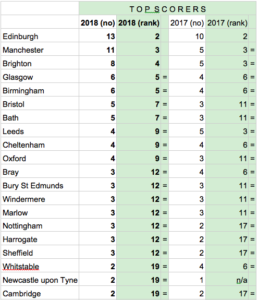 The UK’s best towns for foodies, and Top 100 Restaurants are revealed in Harden’s Best UK Restaurants 2018 published today – the country’s most comprehensive restaurant guide available in bookshops, with approximately twice the number of entries as The Good Food Guide.
The UK’s best towns for foodies, and Top 100 Restaurants are revealed in Harden’s Best UK Restaurants 2018 published today – the country’s most comprehensive restaurant guide available in bookshops, with approximately twice the number of entries as The Good Food Guide.
Read the full Harden’s 100 list here.
Harden’s 27th annual poll of diners, surveyed 8,500 participants who contributed 50,000 reviews, which, as curated by the editors, form the basis for the inclusions and ratings in the guide.
The guide’s editor and co-founder Peter Harden said: “The same week that saw TripAdvisor crown a shed serving Iceland ready meals as London’s top restaurant, saw our guide name the capital’s The Araki as the UK’s best. Both systems rely on user feedback, but it is the careful collation of the Harden’s survey that creates authoritative rankings, rather than trash listings based on unfiltered garbage data.”
Of the Harden’s 100 Best UK Restaurants (see below), the split in representation between London and non-London restaurants was exactly 50/50 (so long as you include Kew in the capital). This is the first year the Harden’s 100 list of top restaurants has been published independently from The Sunday Times, who made the ranking the basis of their annual Food List supplement for 6 years from 2010 to 2015.
 After London’s £385-a-head sushi specialist The Araki, second place – and the highest ranking restaurant outside the capital – goes to the Sanchez-Inglesias family’s Casamia in Bristol: “a magical experience with clever cuisine, impeccable service, and yet somehow still with a cosy and friendly feel about it”.
After London’s £385-a-head sushi specialist The Araki, second place – and the highest ranking restaurant outside the capital – goes to the Sanchez-Inglesias family’s Casamia in Bristol: “a magical experience with clever cuisine, impeccable service, and yet somehow still with a cosy and friendly feel about it”.
Manchester (with 66 entries) scores the guide’s biggest total number of inclusions outside the capital, and also shows the fastest growth in the number of ‘Top Scorers’, with 11 establishments rated very good or excellent at the price: more than double last year’s figure of five. The city still lacks a restaurant within the Harden’s 100 Best UK Restaurants however, although nearby Stockport newcomer Where The Light Gets In does feature at No. 72.
North of the border, Edinburgh (with 55 listings), is still unrivalled outside London in terms of quality, with 13 restaurants amongst the guide’s top scorers. Of these, three are in the Harden’s 100: Restaurant Martin Wishart (at 9), The Kitchin (at 47) and Norn (at 66).
The West Country put in a strong showing with Bath and Bristol both climbing from 11= to 7= in terms of the number of Top Scorers in the guide. With Bristol featuring not only Casamia in the Harden’s 100 but also Wilks (at 65), it looks set to overtake Brighton (which has two more entries, but no restaurants in the Harden’s 100) in the UK’s Top-5 most interesting cities for dining out.
 Birmingham is the only other large conurbation to feature two or more Harden’s 100 listings with Adams (at 32) and Purnell’s (at 88). The city suffers by comparison with other locations in terms of the level of overall interest however, ranking only 13= in terms of number of overall entries in the guide. The only other location with two entries in the Harden’s 100 is foodie enclave Bray, with The Fat Duck (at 5) and Waterside Inn (at 7).
Birmingham is the only other large conurbation to feature two or more Harden’s 100 listings with Adams (at 32) and Purnell’s (at 88). The city suffers by comparison with other locations in terms of the level of overall interest however, ranking only 13= in terms of number of overall entries in the guide. The only other location with two entries in the Harden’s 100 is foodie enclave Bray, with The Fat Duck (at 5) and Waterside Inn (at 7).
Wales put in a strong performance quality-wise this year. Although its overall number of listings in dwarved by Scotland’s it achieved five rankings in the Harden’s 100: Gareth Ward at Ynshir in Eglwys Fach (at 15), Tyddyn Llan in Llandrillo (at 38), Llangoed Hall in Llyswen (at 49), Restaurant James Sommerin in Penarth (at 74), and The Whitebrook in Whitebrook (at 76). Meanwhile Cardiff enters the Top 20 cities in terms of number of entries in the guide.
Other than the three Edinburgh restaurant’s noted above, Scotland’s representatives in the Harden’s 100 were Andrew Fairlie in Auchterarder (at 35), The Three Chimneys in Dunvegan (at 68) and The Peat Inn Cupar (at 94). Glasgow lacks any representatives in the Harden’s 100, but put in a strong showing as the 5= city outside London in terms of Top Scorers and 6= in terms of the total number of entries.



